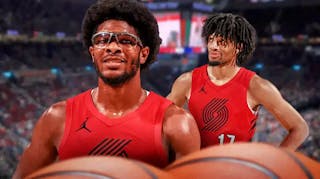Anfernee Simons enters 2021-22 coming off a relative breakout season, at least when accounting for the gravity of his struggles over his first two years in the NBA. Fully established as a rotation player with the Portland Trail Blazers now, rookie coach Chauncey Billups is finally affording Simons the opportunity to prove his bona fides as a point guard.
“Obviously, they know I can score the ball, and they don’t want to take that away from me,” Simons told The Athletic's Jason Quick of the Blazers' new coaching staff. “But right now they are kind of opening up my game and seeing what I can do and grow into becoming.”
Simons' ultimate ceiling is a popular parlor game in Portland. Some remain enticed by his mouth-watering blend of effortless shooting ability and vertical explosion, still confident he can grow into a star. Others believe Simons lacks the stylistic versatility and overall feel with the ball to be much more than a quality bench player, deep threes and highlight-reel dunks be damned.
The good news for the Blazers is they don't need Simons to truly breakout this season. Building on his improvements of 2020-21 and just partially plugging some of the holes in his game will be more than enough for Simons to cement himself as a solid reserve guard for a team that needs it behind Damian Lillard and C.J. McCollum.
Here are three ways Simons can take that leap in 2021-22.
Put Any Pressure On The Rim
You'd hardly know Simons is the league's reigning Slam Dunk Contest champion by watching him play. He had just three dunks last season, one more than the notoriously ground-bound McCollum. That's a disappointing total for one of basketball's best leapers, of course, but no doubt one Portland would live with going forward as long as Simons attacks the rim with any sort of regularity.
Simons averaged 2.3 drives per game last season, per NBA.com/stats, an unacceptably low number despite his lack of playing time. Rajon Rondo, for instance, not exactly goading aggressive close-outs and still averse to finishing in the paint, came close to tripling Simons' rate of drives while getting slightly fewer minutes.
Billups' movement-based offensive attack will lead to Portland penetrating more frequently by itself, especially as he continues emphasizing the ripples attacking the rim. Simons has the tools to benefit from the Blazers' updated approach to offense more than any of his teammates, with a lethal jumper and the leaping ability to theoretically play bigger than his size as a finisher. His two-footed preference for jumping limits that perceived potential to finish over or around length in the paint, and Simons has yet to compensate with a viable floater game, shooting 24.4 percent on paint shots outside the restricted area last season.
Portland would obviously love for Simons to suddenly become a consistent, variable finisher off drives, equally capable of posterizing seven-footers when he has the space to load up, extending around shot-blockers with either hand or avoiding them altogether with floaters. That's a bridge much too far for what Simons has shown so far in his career, though. For now, simply creasing the paint when he's run off the three-point line and getting his shoulder past his defender in pick-and-roll will be enough for Simons to become a nightly impact player for the Blazers off the bench, whether his jumper is falling or not.
Significantly Increase His Assist Rate
Dreams of Simons ever emerging as a good team's primary ball handler are long gone. He was drafted in 2018 as a combo guard, closer to the mold of McCollum than Lillard, and lacks the ball-handling chops that help the former see and create passing lanes he wouldn't otherwise. Billups is under no delusion that Simons is ready to play point guard full-time. He'll be splitting that role with McCollum when Lillard is off the floor, and there's next to no difference between responsibilities of the nominal point guard and shooting guard in Billups' offense anyway.
Simons assisted on 11.4 percent of Portland's possessions when he was on the floor last season, about half of McCollum's rate and the same as seldom-used big man Harry Giles'. That number certainly isn't a positive endorsement of Simons' playmaking potential, but also deserves context of its circumstances. Simons basically played caretaker for the Blazers' second unit, his most important job bringing the ball up the floor before feeding McCollum or Carmelo Anthony for rote pick-and-rolls and post-ups.
Even so, Simons flashed some measure of comfort making plays for others last season on the rare occasions he exercised the freedom to do so. These aren't high-level reads by any means, but still indicative of meaningful growth in Simons' ability to break down defenses with the dribble and pass.
Simons won't be slicing up defenses anytime soon, obviously. But he can still be more than a glorified shooting and scoring specialist, and Billups' quick-hitting, read-and-react offense could be the perfect catalyst for Simons to expand his breadth as a passer.
Sustain Defensive Intensity
The numbers painted Simons as one of the worst defenders in basketball last season. He ranked fifth from last among 250 qualified players in FiveThirtyEight's Defensive RAPTOR and fared even worse in Basketball Index's Defensive LEBRON. The catch-all defensive metric that accurately gauges a defender's performance doesn't exist, but it's telling that Lillard, Anthony and Enes Kanter ranked in the bottom 25 of both categories. There's no argument Simons was even a net-zero defensively for Portland last season.
But like his strides as a passer, Simons took small yet significant ones on defense, too—especially over the last couple months of the regular season.
Simons' engagement and intensity ticked up a notch once Terry Stotts made him a fixture of the Blazers' rotation in March. He wasn't completely immune from the miscommunication and mental lapses that plagued the entire roster, but Simons also proved he doesn't have to be a defensive liability. His mind caught up with his arms and feet defensively the more Simons saw the floor, allowing him to make multiple efforts on the same possession and stay scheme consistent while disrupting the offense.
Portland's defense will be much more active under Billups, relying on weak-side and back-line rotations as two defenders pressure the ball in pick-and-roll. It's a major adjustment for every returnee, but one Simons—like all of his teammates, actually—is glad to be making.
“We're gonna have a more aggressive play style on that end,” he said at Media Day, “and be able to have people play to their strengths, make plays, take risks if they need to, so I'm pretty excited about that.”
Simons won't be an individual stopper or consistently impactful help defender in 2021-22. Those descriptions only apply to a select few players his size, and the weight Simons added over the offseason won't suddenly turn him into Patrick Beverley or Derrick White. Simply becoming an average defender will be more than enough for Simons given his offensive influence. As long as he sustains the edge Billups demands on that side of the ball, anything less would be a disappointment given the subtle progress Simons made a year ago.




